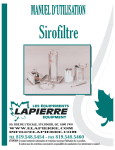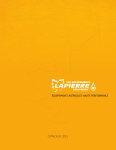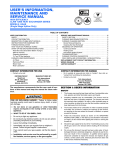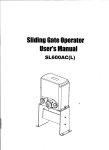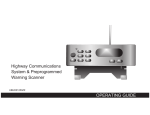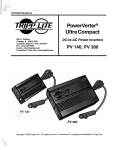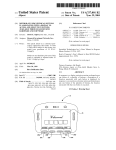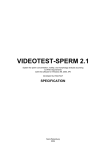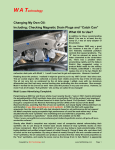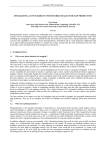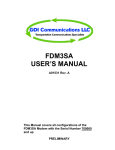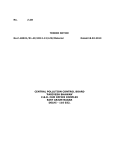Download RO operation manual-2 mars-v_07.cdr
Transcript
TURBO R.O. & TURBO New Generation R.O. 99, RUE DE L’ESCALE, ST-LUDGER, QC. G0M 1W0 WWW.ELAPIERRE.COM [email protected] TEL 819.548.5454 - FAX 819.548.5460 CAUTION : This manual includes information and restrictions concerning these products use and restrictions in regards to the manufacturer responsibilities. Manuel must be read attentively. 14 USER MANUAL REVERSE OSMOSIS SYSTEM The system significantly reduces the time and energy required for the sap evaporation process. It also improves the efficiency of the operation. The concentration process of the maple sap reduces the volume of green house gases into the atmosphere due to reduced combustion of wood or fossil fuels, while greatly contributing to the conservation of long term renewable energy sources. REVERSE OSMOSIS SYSTEM Concentrating maple sap using a reverse osmosis system allows the producer to reduce his energy input by 75% or more. 2 ADVANTAGES OF USING AN R.O. -Reduced energy input -Time and labour saving -Allows the expansion of sugar operations -Maximize efficiency of evaporation equipment -Helps to protect the environment TABLE OF CONTENTS -Available Models 4 -Electrical Panel Details 5 -R.O. Parts Identification 6 -Turbo New Generation R.O. Installation Diagram 7-8 9 -Start-up 10 -Membrane Installation 11 -Membrane Element Conditioning 12 -Operating Instructions: Concentration 13 -Flow Meters Adjustment 14 -Concentration & Performance Test 15 -Operating Instruction: Rinse Cycle 16 -Necessity of Proper Membrane Wash -Operating Instructions: Soap Washing the Membrane -Membrane Performance Test 17 - 18 19 20 - 22 -Storage Procedure 23 -Operating Instructions: Washing the Membrane for Storage 24 -Factors Affecting R.O. Membrane Performance 25 -Effect of Pressure, Temperature, Salt Concentration, Recovery & PH 26 - 30 -Troubleshooting 31 - 32 -Sources of Information 33 -Sources of Information 33 -Appendix 34 35 36 37 1 Performance Test Log Table 2 Correction Factors 3 Membrane Performance Table 4 Specifications all Models TABLE OF CONTENTS -Turbo R.O. Installation Diagram 3 AVAILABLE MODELS AVAILABLE MODELS 2000 series NG-8041-125-3HP NG-8042-250-3HP NG-8140-600-5HP 8041-125-3HP 8042-250-3HP 8140-600-5HP NG-8240-1200-10HP NG-8340-1800-15HP NG-8440-2400-20HP 8240-1200-10HP 8340-1800-15HP 8440-2400-20HP OPTIONAL Vessel racks 4 3000 series Wash tanks Wash tank / sap filters ELECTRICAL PANEL 2000 series High temperatur light Out of order light Recirculation running light Temperature monitor on/off Feed pump Temperature monitor on/off Feed pump on/off High pressure pump (1 switch/pump) on/off High pressure pump (1 switch/pump) Recirculation running light 8041-125-3HP 8042-250-3HP 8140-600-5HP Out of order light NG-8041-125-3HP NG-8042-250-3HP NG-8140-600-5HP High temperature light 3000 series Recirculation running light Out of order light Temperature monitor on/off Feed pump ELECTRICAL PANEL High temperature light Temperature monitor on/off High pressure pump (1 switch/pump) on/off Feed pump on/off High pressure pump (1 switch/pump) Recirculation running light High temperature light 8240-1200-10HP 8340-1800-15HP 8440-2400-20HP Out of order light NG-8240-1200-10HP NG-8340-1800-15HP NG-8440-2400-20HP 5 PARTS IDENTIFICATION Permeate flow meter High pressure gauge Instructions label Concentration Low pressure adjustment valve (#2) gauge Wash/concentration valve(#3) DOUBLE HORIZONTAL MECANIQUE RELACHEURPARTS IDENTIFICATION Concentrate flow meter Concentrate sampling valve wash tank High pressure vessel Electrical control panel model & serial # inside panel Sap inlet Permeate outlet Outlet to high pressure vessel Heat element Thermostat (optional) Pressure shut-off valve (#4) Concentrate flow meter Concentrate sampling valve Instructions label High pressure gauge Permeate Outlet Concentrate return inlet Pressure control valve(#1) High Pressure feed manifold Feed pump High pressure pumps Recirculation Pump Low pressure gauge Permeate flow meter Wash/concentration valve(#3) High pressure outlet manifold Concentration adjustment valve (#2) Pressure control valve(#1) Permeate valve(#6) Electrical control panel model & serial # inside panel feed pump 64 High pressure outlet manifold Concentrate valve(#5) Pressure shut-off valve (#4) High Pressure feed manifold High pressure pumps Follow arrows on handles to determine flow direction ex: If the top valve is on Wash/drain, liquid is going down to the bottom valve Concentrate Permeate tank tank Out to concentrate tank Inlet Out to permeate tank Inlet drain wash tank drain wash tank In from permeate flow meter (back of R.O.) From high pressure pump manifold In from concentrate flow meter(back of R.O.) To wash tank Out to bottom of permeate flow meter Concentrate flow meter To concentrate return inlet Permeate flow meter Pre filter To drain Wash tank feed valve (C) IN High pressure feed manifold From permeate tank Lower outlet out to drain Feed pump outlet Feed pump inlet From sap tank Permeate feed valve (B) Sap feed valve (A) OUT HORIZONTAL DOUBLE MECANIQUE RELACHEUR TURBO R.O. INSTALLATION DIAGRAM TURBO R.O. INSTALLATION DIAGRAM 1 PRESSURE VESSEL & EXTERNAL VALVE PANEL If using an 8’’ sap-filter, a wall or a wash tank mount (series of pre filters on a frame), hook up the inlet of the pre filter to the feed pump and the outlet of the pre filter to the high pressure pump manifold inlet. 5 7 84 Out to concentrate tank For draining: HORIZONTAL DOUBLE RELACHEUR TURBO MECANIQUE R.O. INSTALLATION DIAGRAM TURBO R.O. INSTALLATION DIAGRAM 2 PRESSURE VESSELS & NO EXTERNAL VALVE PANEL Out to permeate tank In from permeate flow meter (back of R.O.) Out to bottom of permeate flow meter From high pressure pump manifold In from concentrate flow meter (back of R.O.) Concentrate To wash tank flow meter Permeate flow meter To drain To concentrate return inlet Pre filter Wash tank feed valve (C) From permeate tank IN Lower outlet out to drain Feed pump outlet Feed pump inlet From sap tank Permeate feed valve (B) Sap feed valve (A) For R.O. with built-in pressure vessels (125 et 250 GPM) simply ignore the hoses going to external pressure vessels OUT IN OUT Four position valve detail Out to bottom of permeate flow meter From high pressure pump manifold To concentrate return inlet Wash tank feed valve (C) IN From permeate tank OUT Lower outlet out to drain From sap tank Permeate feed valve (B) Sap feed valve (A) to Feed pump inlet HORIZONTAL MECANIQUE RELACHEUR TURBO NEW GENERATION R.O.DOUBLE INSTALLATION DIAGRAM TURBO NEW GENERATION R.O. INSTALLATION DIAGRAM 1 PRESSURE VESSEL 5 9 START-UP - Install the membrane according to the instructions shown on the recirculation vessel. - Before inserting the membrane in the pressure vessel, make sure that the u-cup on the membrane and all the ‘o'rings on the adaptors are in perfect condition. - Always lightly coat the u-cup and all the ‘o'rings with silicone food grade lubricant (Dow Corning supplied in accessories box) before their installation. START-UP - Once the membrane installation is completed, connect all the high pressure hoses to the reverse osmosis and at the base of the recirculation pump(s). - Make sure that all the plumbing is in good condition. - If the equipment was stored in an unheated room, warm up the room for 2 days before starting the pumps. This precaution will avoid damage to the pumps if ice has formed inside of the system. - To start the equipment open the valve on the sap feed line and let the sap fill the unit by gravity. It is important to thoroughly rinse the membrane before you begin the concentration. You must follow the rinse instructions and start the equipment. WARNING IF the RO has been out of service for the off season, before starting it up, you should take a screwdriver and rotate all electrical motors one or two revolutions WARNING For a multi vessel machine (3 and more), make sure the recirculation cord is disconnected from the RO to avoid running the pump dry. Start the feed pump, wait until the fluid goes through the flow meter. Stop the machine , reconnect the electric cord of the recirculation pump to the RO. When draining the RO, make sure to repeat this operation at the next start up. There is an optional flow switch available to avoid doing this procedure. The flow switch is standard on 6 vessel R.O.’s. 10 There is a video explaining concentrate cycle, rinse and soap wash cycle available for viewing on www.elapierre.com. Click on the video tab from the top menu and then, New Generation R.O. operating/washing instructions. 4’’ membrane 8’’ membrane INSTALLATION DE LA MEMBRANE MEMBRANE INSTALLATION INSTALLATION DE LA MEMBRANE MEMBRANE INSTALLATION U-CUP VÉRIFIER LES O’RINGS VÉRIFIER LES O’RINGS CHECK THE O’RINGS CHECK THE O’RINGS VOTRE MEMBRANE POSSÈDE SEULEMENT UN (1) U-CUP, DONC ENTREZ CE BOUT DE LA MEMBRANE VERS LE BAS DU CAISSON. VOTRE MEMBRANE POSSÈDE SEULEMENT UN (1) U-CUP, DONC ENTREZ CE BOUT DE LA MEMBRANE VERS LE BAS DU CAISSON. ONLY 1 U-CUP IS REQUIRED ON YOUR MEMBRANE. THE END WITH THE U-CUP MUST BE DIRECTED TOWARD THE BOTTOM OF THE PRESSURE VESSEL. ONLY 1 U-CUP IS REQUIRED ON YOUR MEMBRANE. THE END WITH THE U-CUP MUST BE DIRECTED TOWARD THE BOTTOM OF THE PRESSURE VESSEL. VÉRIFIER LES O’RINGS VÉRIFIER LES O’RINGS CHECK THE O’RINGS U-CUP CHECK THE O’RINGS PIÈCES À ASSEMBLER AU BAS DE LA MEMBRANE AVANT DE L’INTRODUIRE DANS LE CAISSON. PIÈCES À ASSEMBLER AU BAS DE LA MEMBRANE AVANT DE L’INTRODUIRE DANS LE CAISSON. PARTS TO BE ASSEMBLED AT THE BOTTOM BEFOM INTRODUCING THE MEMBRANE IN THE VESSEL. PARTS TO BE ASSEMBLED AT THE BOTTOM BEFOM INTRODUCING THE MEMBRANE IN THE VESSEL. ENDUIRE LES O’RINGS DE LUBRIFIANT DE GRADE ALIMENTAIRE LORS DE L’INSTALLATION. ENDUIRE LES O’RINGS DE LUBRIFIANT DE GRADE ALIMENTAIRE LORS DE L’INSTALLATION. APPLY A THIN COAT OF FOOD GRADE LUBRICANT ON THE O’RINGS. APPLY A THIN COAT OF FOOD GRADE LUBRICANT ON THE O’RINGS. 819.548.5454 MEMBRANE INSTALLATION MEMBRANE INSTALLATION 819.548.5454 11 MEMBRANE CONDITIONING Prior to performing maple sap concentration, it is important to follow these instructions. The membrane is called hydrophobic in its original state, meaning it will allow water through its pores with difficulty. The purpose of the conditioning is to make the membrane hydrophilic. MEMBRANE CONDITIONING This way the membrane will allow water to pass freely through its pores at a lower pressure. PROCEDURE STEP 1 Rinse with water to drain for 15 minutes Note: If no permeate is available, you can then use tap water. If using tap water, make sure this water does not contain a large mineral load. It must also be chlorine free. We also recommend you test the PH. the PH should read between 6 and 7.5 STEP 2 Recirculate 85°F (29.4°C) water in the wash tank for 30 to 45 minutes following the wash cycle instructions. This step can be performed with or without membrane cleaner, depending if the element is new or used. STEP 3 Rinse to drain with 500 gallons of water. You can now proceed to concentration. Note: At the end of your first concentration day, we recommend performing a mild chemical wash (check manufacturer's PH recommendations), followed by a thorough rinse with permeate water. NOTE 12 OPERATING INSTRUCTIONS CONCENTRATE CYCLE 1. Open sap feed valve (A). 2. Make sure permeate valve (B) and wash tank valve (C) are closed. 3. On the RO front panel set Valve #1 (high pressure control) – open 2 turns. 4. On the RO front panel turn Valve #2 (concentrate needle valve) - open one quarter turn. 6. On the RO front panel make sure the four position concentrate valve is set to Concentrate Reservoir # 1 position. (If using an external valve panel (turbo model) place the top concentrate valve on Reservoir) 7. On the RO front panel make sure the four position permeate valve is set to Permeate Reservoir # 2 position. (If using an external valve panel (turbo model) place the top permeate valve on Reservoir). 8. On the RO front panel push the (green) feed button until pressure reaches 25psi on lower pressure gauge then release the feed button. 9. Once flow starts automatically – push high pressure green start button. You are now concentrating the sap. Double check that sap concentrate is going into the sap concentrate tank. 10. On the RO front panel set valve #1 pressure between 250 psi and 400 psi. on the high pressure gauge. 11. Adjust concentrate #2 on the R.O. front panel, to concentrate at approximately 8 Brix (remove 2 thirds of the water from total liquid) permeate gauge set to 6 gpm, concentrate gauge set to 3 gpm (refer to the next page: flow meters adjustment). 12. Wait 3 to 5 minutes, and then adjust valve #2 on the R.O. front panel, to get desired concentration. Try and balance the concentrate with what the evaporator is using, i.e. maintain a constant level in the concentrate tank or just slightly increase the level of concentrate in the tank particularly on a long boil. OPERATING INSTRUCTIONS 5. On the RO front panel make sure Valve #3 is on concentrate closed cycle. 13. After RO has run for 10 minutes, switch only the permeate 4 position valve to wash position (If using an external valve panel (turbo model) place the bottom permeate valve on wash and then, the top permeate valve to wash/drain) and fill stainless steel wash tank ¾ parts full with clean permeate for rinsing the membrane. Return permeate valve to reservoir position. Turn on heating element in the wash tank to heat the rinsing water. 14. If the RO runs out of sap and shuts down or has reached the maximum concentration time of 6 – 7 hours, then shut down and rinse the membrane as explained in the rinse cycle operating instructions 13 FLOW METERS ADJUSTMENT Permeate flow meter Concentrate flow meter GPM:Gallons/Minute LPM:Liters/Minute FLOW METERS ADJUSTMENT Read on top of the Lead float To determine the percentage of concentration, divide the permeate flow by the total of the permeate and the concentrate.. Ex. : concentrate= 2.5 GPM permeate= 7.5 GPM Percentage of concentration: 7.5 / (2.5 + 7.5)= 75 % concentration Lead float Example 1: Example 2: Sap: 2 brix Concentrate: 4 brix 50% water removal from total liquid CONCENTRATE GPM LPM PERMEATE GPM 20 CONCENTRATE LPM GPM 20 LPM PERMEATE GPM 20 LPM 20 18 70 18 70 18 70 18 70 16 60 16 60 16 60 16 60 14 14 50 12 10GPM Sap: 2.5 brix Concentrate: 7.5 brix 75% water removal from total liquid 10 8 40 30 10 8 12 40 10GPM 10 8 30 6 20 4 2 40 30 10 8 2.5GPM 2 40 30 7.5GPM 6 20 4 10 50 12 6 20 4 10 14 50 12 6 2 14 50 20 4 10 2 10 WARNING To make sure the permeate is free of sugar, an easy test is to evaporate 1 gal (4 L) down to 1.5 oz (40ml) after 1 or 2 hours of operation, let it cool down and taste it. The concentration should be high enough to taste sweet. If there is sugar in the permeate, repeat this test 1 or 2 hours later. If it still tastes sweet, check the condition of the ‘o’rings at both ends of your membrane (refer to the membrane installation diagram) 14 CONCENTRATION & PERFORMANCE TEST You should always fill in a log table(see appendix 1). The purpose of the log table is to keep a data of all parameters during the operation and performance test of your equipment. (see performance test section for more details) To evaluate the good working order of the reverse osmosis equipment it is important to know the parameters detailed in performance tests. The use of reverse osmosis in the maple industry has a direct impact on operation costs. The cost of combustible fuels and labour keep increasing and will probably remain high into the future. For all these reasons, many producers are looking to reduce their expenses to keep a reasonable profitability of their operation. R.O. system is more and more targeted to increase the concentration level above 8 brix. It is possible to do so. However, it will be necessary to plan an additional installation of extra membrane elements. This installation can be justified by the saving of energy and labour required for sap processing. The following cost comparison chart and graphic demonstrate the energy-saving generated by the concentration increase of maple sap. Optional outlets: If you plan to expand in the future, optional factory installed outllets are available for future extra vessels plug-in capabilities. Ex: At 4 Brix it takes 2g of oil to make 1 gal of syrup At 8 Brix it takes 1g of oil to make 1 gal of syrup On an average efficiency oil fired evaporator CONCENTRATION & PERFORMANCE TEST INCREASE OF CONCENTRATION NOTE 15 OPERATING INSTRUCTIONS RINSE CYCLE 1. Close sap feed valve (A). Open permeate feed valve (B). OPERATING INSTRUCTIONS 2. On the RO front panel open Valve #3 (concentrate valve) to the wash position. Leave the 4 way concentrate valve to the concentrate tank. (If using an external valve panel (turbo model) place the top concentrate valve on Reservoir) Start the green feed pump only and run for 5 minutes. This pushes all the sugar centrate from the membrane to the concentrate tank.Shut off the feed pump and switch the concentrate 4 way valve to drainIf using an external valve panel (turbo model) place the bottom concentrate valve to drain and then, the top concentrate valve on wash/drain) Run this rinse for 15 minutes and then shut the RO off. 3. Close the permeate feed valve (B) and open the wash tank feed valve (C). Set the 4 way concentrate valve to wash position, set the 4 way permeate valve to wash position. (If using an external valve panel (turbo model) place the bottom permeate valve to wash and then, the top concentrate valve on wash/drain). 4. Turn off heating unit on the wash tank. 5. Start the green feed pump and let run until it shuts off automatically (43 degrees C.) You do not need to stay at the camp for this operation. 6. When you return to the camp in the morning drain the wash tank. 7. Close the wash tank feed valve (C) and open permeate feed valve (B). 8. Start the green feed pump only and rinse the membrane for 15 minutes minimum. If the RO is not going to be used for two or three days rinse the membrane daily for five to ten minutes with valves in the same position. 9. Your membrane is ready to return to concentration cycle (1-10 above) . 10. When your membrane output slows down by 10% you need to do a soap wash. Please follow the soap washing instructions carefully. There is a video explaining concentrate cycle, rinse and soap wash cycle available for viewing on www.elapierre.com. Click on the video tab from the top menu and then, New Generation R.O. operating/washing instructions. NOTE 16 CLEANING THE NECESSITY OF A PROPER MEMBRANE WASH All filtration systems require cleaning at more or less regular interval to allow constant flow. The membrane is a filter. It can retain invisible molecules and particles. The accumulation of these molecules on the surface of the film result in a gradual decrease of the volume of water passing through the membrane film, which results in: Reduction of the permeate flux. Reduction of the concentrate brix. A pressure increase. A permeate flow drop of around 10% to 15% should be corrected promptly by a soap wash. It is also important to monitor regularly the membrane performance because a major performance drop may result in irreversible damage. In some cases it may be necessary to wash more than once to bring the membrane performance back. CLEANING - Membrane Semi permeable film that retains the organic and minerals while allowing water to pass through. Feed mesh (vexar) Mesh which acts as a feed channel and for the membrane recirculation. Permeate mesh (vexar) A fine mesh that allows the permeate to flow towards the perforated tube at the center of the element. 17 CLEANING THE NECESSITY OF A PROPER MEMBRANE WASH WARNING When washing, you must follow the manufacturer's recommendations. There are different types of membranes available on the market. The cleaning product concentrations may vary from one manufacturer to the other. The cleaning solution's PH (water & detergent) must be adjusted according to the membrane specifications. We recommend using a PH meter or a PH test paper strip to determine the required detergent quantity to prepare the cleaning solution. Cleaning is always followed by a rinse with sufficient quantity of permeate. For best results, we recommend using a 25°C (77°F) permeate. The minimum quantity required for an 8 inch membrane is 500 gallons. Increase rinse time by five minutes (100 gal.) for every additional membrane mounted in series. CLEANING In order to get the maximum lifetime of your membranes you should: -Follow the manufacturer's recommendations. -Follow up on the equipment performance. -Do the proper cleaning and rinsing when necessary. -Never improvise home remedies such as chlorine or other non-recommended products. -Never leave the membrane in a concentrated sap solution when the equipment isn't running. -Always perform a short rinse immediately after concentration cycle stops. NOTE 18 OPERATING INSTRUCTIONS SOAP WASHING THE MEMBRANE 1. After you have determined that you need to do a soap wash and have completed steps 1 to 4 from the rinse cycle. (refer to OPERATING INSTRUCTIONS, CONCENTRATE CYCLE ). 2. Start the green feed pump and note the temperature of permeate rinse, it should be at least 28 degrees C. 3. Add soap to the wash tank slowly measuring the quantity used, test with litmus paper to measure ph of the soap solution. Continue adding soap and measure the PH until you reach a PH level of 11 for a Mark 1 membrane. Once you have reached the desired PH level record how much soap was used to achieve the desired PH level. This will allow you to simply add this amount of soap to the wash tank the next time. It is important to always have the same amount of permeate in the wash tank every time. 5. Drain the wash tank and the RO, allow it to cool for 15 minutes as adding cool rinsing permeate could cause the flow meters to break. 6. Close the wash tank feed valve (C) and open permeate feed valve (B). 7. Set the 4 way concentrate valve to drain position, set the 4 way permeate valve to drain position (If using an external valve panel (turbo model) place both bottom valves to drain). 8. Start the green feed pump only and rinse the membrane for 20 minutes minimum. 9. Remove the filter cartridge from the big blue housing at the front of the RO and replace it with a new filter cartridge. Tag the removed cartridge to be used for soap washing only. Once a filter cartridge has been used for soap washing, it may never be used again for sap. 10. If you have lots of permeate, a longer rinse cycle to remove the soap is desirable. Soap left in the membrane can cause an off-flavor in your syrup. OPERATING INSTRUCTIONS 4. Circulate the washing solution for 15 minutes. Turn off the feed pump for 15 minutes. Repeat this process 2 more times. NOTE 19 MEMBRANE PERFORMANCE TEST After purchasing a new R.O., or a new membrane, on the second day of use, check the performance of the membrane(s) after a warm wash and cold permeate rinse. The permeate flow meter reading will be your reference 100%. To check the performance of a membrane, you must concentrate permeate. We recommend that you set the pressure at 225 PSI and adjust the concentrate flow at 3 GPM. MEMBRANE PERFORMANCE TEST Once the permeate data reading is taken from the flowmeter, you divide the data flow by the temperature correction factor. The permeate flow is influenced by the temperature. The higher the sap temperature, the higher the permeate flow will be and vise-versa. (see appendix 2 for correction factors table) A permeate flow drop of around 10% to 15% should be corrected promptly by a soap wash. It is also important to monitor regularly the membrane performance because a major performance drop may result in irreversible damage. In some cases it may be necessary to wash more than once to bring the membrane performance back. To figure out the 100% capacity of the membrane at 13°C (55.4°F). 5.2 GPM / 0.866 (correction factor 8°C (46.4°F) = 6.00 GPM. This result must be written down to compare the performance of the membrane for a minimum of once/month. Therefore, if we wish to revise the performance of the membrane at a given moment, we must redo the above exercise and compare the result to the original test of the membrane. Ex. : If we get 5.5 GPM at the second test (corrected at 13°C (55.4°F)) the performance of the membrane would be: ((6.00 - 5.5) / 6.00) x 100 = 8.3% performance loss OR 5.5 / 6.0 = 91.7% efficiency (see appendix 3 for membrane performance table) NOTE 20 PERFORMANCE TEST (REFER TO LOG TABLE IN APPENDIX 1) 1. Brix percentage of the raw sap. It is the sap before the concentration process. Take note that the liquid temperature influences the reading on the hydrometer or refractometer. Always check the temperature range of the brix measurement device. 2. Brix percentage of the concentrate. This test is normally performed after 15 to 30 minutes of operation. For the measurement, follow the recommendations for the raw sap. 4. Concentrate flow Follow the permeate flow procedure. 5. Total flow To evaluate the total flow. Add the data of the column #3 (permeate) and column #4 (concentrate). The result will be the total flow per minute. Multiplied by 60 minutes you get the total flow per hour. Ex. : 2+8X60= 600 GPH Take note, this data is influenced by temperature variation. The degree of concentration, the condition of the sap, the condition of the membranes and the operation pressure (PSI). 6. Concentration percentage The purpose of knowing the percentage of concentration, is to make sure not to exceed the operation recommendation. PERFORMANCE TEST 3. Permeate flow Note the reading of the permeate flow meter in litres or gallons per minute. To find out the flow per hour, multiply the data per 60 minutes. Ex. : 3 GPM x 60 minutes = 180 GPH Ex. : For a R.O. equipped with a 600 GPH pump and a membrane of 600 GPH the degree of concentration should not exceed 70%. By increasing the filtration surface by the addition of extra membranes, it is possible to surpass this recommendation to obtain a concentrate with a higher level of sugar and minerals. The osmotic pressure increases with the degree of concentration and has a down effect on the membrane flow. There is a video explaining concentrate cycle, rinse and soap wash cycle available for viewing on www.elapierre.com. Click on the video tab from the top menu and then, New Generation R.O. operating/washing instructions. NOTE 21 PERFORMANCE TEST 7. Operation Temperature The operation temperature, is the temperature of the sap at the inlet of the equipment. The temperature of the sap has a direct effect on the permeability of the membrane. The colder the sap is, the lower the flow through the membrane film will be. To make the evaluation of the treatment capacity of the membrane, we must refer to the temperature correction factor. (appendix 2) PERFORMANCE TEST 8. Pressure of Operation The pressure of operation is another important element when conducting a performance test. The pressure has a direct effect on the flow and the permeability of the membrane. To raise the level of concentration requires an increase of the pressure to maintain the flow. For the long life of the membranes, it is preferable to operate at a lower pressure than the recommended limit. Always perform the performance test at the same pressure. It is important to maintain a good reference. 22 9. Corrected Permeate Flow Divide the reading of the permeate flow meter by the appropriate temperature correction factor. (appendix 2) NOTE STORAGE PROCEDURE At the end of the maple season, it is time to prepare your equipment for storage. To begin, you must make sure that you have a good volume of permeate to allow a proper wash and rinse of your membranes. 1. Even if you send your membrane(s) to be washed by the equipment manufacturer, it is important to wash and rinse the membranes before pulling them out of the recirculation vessel. 2. Disconnect the pressure hoses from the pressure vessels and the electric cord from the R.O. 4. Insert the membrane(s) in the canister(s). If you send the units to the factory, add 1 litre of permeate to the canisters. The membranes must be kept in a damp environment. Long storage solution : for each 8” x 40” membrane: mix ½ cup of SMBS (sodium metabisulfite) with 4 gallons (18 litres) of cold permeate and 1 gallon (3.75 litres) of glycerine(to avoid freezing). Mix well and add the solution to the membrane in the storage canister. For 4” x 40” membrane mix 1/8 of a cup of SMBS to 1 gallon (4.5 litres) of cold permeate and add 1 litre of glycerine, mix well. 5. Drain the unit and all pumps completely. 6. It is strongly recommended to store the R.O. in a dry and heated room. This precaution will avoid certain problems due to humidity and bad surprises caused by an incomplete drainage. There is a video explaining concentrate cycle, rinse and soap wash cycle available for viewing on www.elapierre.com. Click on the video tab from the top menu and then, New Generation R.O. operating/washing instructions. STORAGE PROCEDURE 3. Unfasten the bolts from the top lid(s) and pull the membrane(s). NOTE 23 WASHING THE MEMBRANE FOR STORAGE 1. When washing your membrane for end of year storage, the procedure is very similar to membrane washing. Repeat steps1-2-3 from the: SOAP WASHING THE MEMBRANE section. WASHING THE MEMBRANE FOR STORAGE 2. During this process you must use a long washing Cycle. Circulate the washing solution for 30 minutes. Turn off the feed pump for 30 minutes. Repeat this process 2 more times using a circulation of 30 minutes and a rest period of 3 hours. 3. Drain the wash tank and the RO, allow it to cool for 15 minutes as adding cool rinsing permeate could cause the flow meters to break. 4. Close the wash tank feed valve (C) and open permeate feed valve (B). 5. Set the 4 way concentrate valve to drain position, set the 4 way permeate valve to drain position (If using an external valve panel (turbo model) place both bottom valves to drain). 6. Start the green feed pump only and rinse the membrane with at least 500 gallons of permeate. 7. Remove the prefilter and dispose of it. 8. Remove the membrane from the stainless steel vessel, remove the plug and cone from the bottom of it and put the membrane in the storage vessel. Mix ½ cup of SMBS and one litre of clean permeate in a clean pail, stir well and pour over the membrane in the storage vessel. Install the cap on the storage vessel and store in a heated area until it is required for service next season. 9. Replace the cap on the stainless steel vessel and store the plug and cone in a safe place such as a storage cabinet. 10. Remove the high pressure hose from the stainless steel membrane vessel and make sure the drain valve at the bottom of the stainless steel membrane vessel is in the drain position. 11. Make sure the 4 position valves are both drained well. Also make sure the flow gauges have drained. 12. Open the drain valve in the rear of the RO and remove the drain plug from the feed pump and drain well. Tip the machine forward to help drain the unit. 13. Plug any of the hoses going into the RO to prevent varmints from nesting there over the winter. 14. Next season before starting the machine, take a screwdriver, place it in the slot in the end of the electric motor. Repeat this process on all three motors, the feed pump, the high pressure pump and the circulating pump. 15. Lubricate the membrane ‘U’ cup and ‘O’ rings before installing into the stainless steel vessel. 24 FACTORS AFFECTING R.O. MEMBRANE PERFORMANCE What will follow defines the key terms and offers a quick overview of the factors affecting the performance of the reverse osmosis membrane elements. Including the effect of pressure, temperature, concentration of organics, sugars, mineral salts contained in the maple sap, and recovery of permeate and the effect of the PH. NOTE FACTORS AFFECTING R.O. MEMBRANE PERFORMANCE The technology of reverse osmosis can be complicated. Especially in absence of knowledge for the terminology that describes the aspects of the operation in relation with different variables. 25 EFFECT OF PRESSURE Feedwater pressure affects both the water flux and salt rejection of RO membranes. Osmosis is the flow of water across a membrane from the dilute side toward the concentrated solution side. Reverse osmosis technology involves application of pressure to the feedwater stream to overcome the natural osmotic pressure. Pressure in excess of the osmotic pressure is applied to the concentrated solution and the flow of water is reversed. EFFECT OF PRESSURE A portion of the feedwater (concentrated solution) is forced through the membrane to emerge as purified product water of the dilute solution side. Osmosis The water crosses a semi permeable membrane towards the higher concentration area of the liquid to balance the two solutions. Once the level of the liquid is equivalent, the height difference between the concentrated and the diluted part correspond to the osmotic pressure. Reverse osmosis By applying a pressure exceeding the osmotic pressure, the water flow direction will be reversed which is called reverse osmosis. NOTE 26 EFFECT OF TEMPERATURE As Figure 3 demonstrates, membrane productivity is very sensitive to changes in feedwater temperature. As water temperature increases, water flux increases almost linearly, due primarily to the higher diffusion rate of water through the membrane.Increased feedwater temperature also results in lower salt rejection or higher salt passage. This is due to a higher diffusion rate for salt through the membrane. The ability of a membrane to tolerate elevated temperatures increases operating latitude and is also important during cleaning operations because it permits use of stronger, faster cleaning processes. NOTE EFFECT OF TEMPERATURE As shown in Figure 2, water flux across the membrane increases in direct relationship to increases in feedwater pressure. Increased feedwater pressure also results in increased salt rejection but, as Figure 2 demonstrates, the relationship is less direct than for water flux. Because RO membranes are imperfect barriers to dissolved salts in feedwater, there is always some salt passage through the membrane. As feedwater pressure is increased, this salt passage is increasingly overcome as water is pushed through the membrane at a faster rate than salt can be transported. 27 EFFECT OF RECOVERY As shown in Figure 1, reverse osmosis occurs when the natural osmotic flow between a dilute solution and a concentrated solution is reversed through application of feedwater pressure. If percentage recovery is increased (and feedwater pressure remains constant), the salts in the residual feed become more concentrated and the natural osmotic pressure will increase until it is as high as the applied feed pressure. This can negate the driving effect of feed pressure, slowing or halting the reverse osmosis process and causing permeate flux and salt rejection to decrease and even stop (please see Figure 6). The maximum percent recovery possible in any RO system usually depends not on a limiting osmotic pressure, but on the concentration of salts present in the feedwater and their tendency to precipitate on the membrane surface as mineral scale. EFFECT OF RECOVERY The most common sparingly soluble salts are calcium carbonate (limestone), calcium sulphate (gypsum), and silica. Chemical treatment of feedwater can be used to inhibit mineral scaling. NOTE 28 EFFECT OF SALT CONCENTRATION Figure 5 demonstrates that, if feed pressure remains constant, higher salt concentration results in lower membrane water flux. The increasing osmotic pressure offsets the feedwater driving pressure. Also illustrated in Figure 5 is the increase in salt passage through the membrane (decrease in rejection) as the water flux declines. NOTE EFFECT OF SALT CONCENTRATION Osmotic pressure is a function of the type and concentration of salts or organics contained in feedwater. As salt concentration increases, so does osmotic pressure. The amount of feedwater driving pressure necessary to reverse the natural direction of osmotic flow is, therefore, largely determined by the level of salts in the feedwater. 29 EFFECT OF PH The PH tolerance of various types of RO membranes can vary widely. Thin-film composite membranes such as FILMTEC FT30 membrane are typically stable over a broader PH range than cellulose acetate (CA) membranes and, therefore, offer greater operating latitude (see Figure 4). Membrane salt rejection performance depends on PH. Water flux may also be affected. EFFECT OF PH Figure 7 shows that water flux and salt rejection for FILMTEC FT30 membranes are essentially stable over a broad PH range. As illustrated in Figure 4, the stability of FT30 membrane over a broad PH range permits stronger, faster, and more effective cleaning procedures to be used compared to CA membranes. 30 NOTE TROUBLESHOOTING PROBLEMS & SOLUTIONS Problem The feed pump starts, but it stops as soon as I release the feed switch. Solution 1 2 3 4 5 Check if the feed pressure reaches at least 20 psi. Check the feed valve, it must be open. Check the prefilters, they may have to be replaced. Check if the plumbing is not plugged or damaged. A bad joint or bad seal will allow air in the system causing this problem. Check the feed pump. Solution 1 2 3 4 Check if the feed pressure reaches at least 20 PSI. Replace the pre-filter cartridges. Check for obstruction of the feed line or the feed pump. Check the feed pump. Problem The performance of the R.O. equipment drops once it is started. Solution 1 Make sure the recirculation pump is running. Just place your hand under the recirculation pump motor if you feel air circulating the motor is running. If the recirculation system does not operate the membrane will foul rapidly. 2 At the beginning and the end of the sugar season, it is important to do a tight follow up of the membranes condition. During these periods, it is necessary to wash the membranes more often to keep a good level of performance. In the first days of the operation due to the cytoplasmic cells activity inside the maple, the sap has a tendency to foul the membranes. These cells produce an antifreeze like substance, which protects the maple during the winter frost. Frequent washing will be necessary during that period to avoid fouling. TROUBLESHOOTING Problem The feed pump starts, but the R.O. stops as soon as I press on the high pressure switch. NOTE 31 TROUBLESHOOTING PROBLEMS & SOLUTIONS Problem The recirculation pump does not operate Solution Normally when the recirculation fails, it will cause a complete stop of the R.O. the out of order light will come on. 1 Control panel. A Check if the breaker is on the set position.(reset if necessary) (Note: on older models the equipment will keep on running if the recirculation breaker is out. But on the newer models if a breaker is out it will be impossible to restart the equipment. TROUBLESHOOTING B Check if the recirculation overload is on, if it is out, the R.O. stops and the out of order light comes on. C Check the electric wiring to the plug and the connections in the motor. (The R.O. will keep on running despite the recirculation is out.) 2 Recirculation motor. A Check if the recirculation motor can turn freely, using a flat screw driver at the base of the motor. B If the motor turns freely check the electric wiring to the motor. If the wire connections and the power are fed properly through the electric circuit, the motor will have to be repaired or replaced by a qualified technician. Problem There is a squealing noise coming from one of the electric motors. Solution It is not generally a very serious problem. Most likely it is a bearing failure, due to excessive wear or rust caused b dampness. It must be repaired immediately before extensive damage occurs. A qualified technician can replace the bearings and check the pump to make sure it is in good running order. NOTE 32 SOURCES OF INFORMATION -Filmtech (Dow Chemicals) -Complete filtration resource (CFR) Steve Bedard Carl Lapierre Donald Lapierre Steve O’Farrell Don Dodds Jeff Goulet Anick Lapierre Keith Brown Matt Williams Tom Patterson TERMINOLOGY & DEFINITIONS Recovery (permeate) The percentage of the water removed from the raw sap through the membrane. That percentage can be increased by adjusting the concentrate valve. Rejection (concentrate) Concentration percentage of solid residue removed from water by the membrane. Passage Opposite of the rejection. Concentration percentage of solids dissolved into the liquid going through the membrane. Permeate Purified water produced by the membrane. SOURCES OF INFORMATION CONTRIBUTORS Total flow rate The flow of the liquid going through the membrane. Normally measured in litres per minute (LPM) or gallons per minute (GPM). Concentrate flow The concentrate flow coming out from the membrane. This concentrate contains all the organic and mineral residues of the liquid. Measured in litres per minute (LPM) or gallons per minute (GPM). Permeate flow The flow of permeate produced by the surface of the membrane. Measured in liters per minute (LPM) or gallons per minute (GPM). 33 APPENDIX 1 PERFORMANCE TEST LOG TABLE Date 1 2 % Brix of the maple sap % Brix of the concentrate 4 3 5 6 7 8 9 Hour Permeate flow (GPM) Concentrate flow (GPM) total flow (3 + 4) x 60 % Concentration Operation temperature pressure of operation 13 C 375 PSI corrected permeate flow Test 3 / (3+4) PERFORMANCE TEST LOG TABLE 2% 34 8 brix 7.5 2.5 600 GPM 75% concentration Temp ° C Temp ° F Correction factor Temp ° C Temp ° F Correction factor 0 32.0 0.672 13 55.4 1.000 1 33.8 0.695 14 57.2 1.028 2 35.6 0.719 15 59.0 1.055 3 37.4 0.742 16 60.8 1.084 4 39.2 0.766 17 62.6 1.112 5 41.0 0.790 18 64.4 1.142 6 42.8 0.816 19 66.2 1.170 7 44.6 0.842 20 68.0 1.200 8 46.4 0.866 21 69.8 1.229 9 48.2 0.893 22 71.6 1.259 10 50.0 0.919 23 73.4 1.289 11 51.8 0.946 24 75.2 1.319 12 53.6 0.973 25 77.0 1.350 CORRECTION FACTORS APPENDIX 2 CORRECTION FACTORS NOTE 35 MEMBRANE PERFORMANCE TABLE APPENDIX 3 MEMBRANE PERFORMANCE TABLE 36 # membrane 28736465 Data reading Temp ° C Temp ° F Corrected data to 13°C / 55.4 2000 Date 5.2 8 46.4 6.00 (100%) Date 2001 5.1 10 50.0 5.50 (91.7%) 2002 2003 2004 2005 For a multi membranes machine, test all the membranes together NOTE Frame Junior frame Junior frame 2000 2000 -2000 -3000 -2000 -3000 -3000 -3000 R.O. model 100 g/h Junior R.O. 200 g/h Junior R.O. 125 g/h -Turbo -New gen. 250 g/h -Turbo -New gen. 600 g/h -Turbo -New gen. 1200 g/h -Turbo -New gen. 1800 g/h -Turbo -New gen. 2400 g/h -Turbo -New gen. 1 1/4’’ 1 1/4’’ 1 1/4’’ 1 1/4’’ 1 1/4’’ 1 1/4’’ 1’’ 1’’ Feed inlet size 4x 5microns 3x 5microns 2x 5microns 1x 5microns 1x 5microns 1x 5microns 1x 5microns 1x 5microns Prefilter (1 phase) 220 v. (1 phase) 220 v. (1 phase) 220 v. (1 phase) 220 v. (1 phase) 220 v. (1 phase) 220 v. (1 phase) 220 v. (1 phase) 220 v. Volts (1 phase) 115 @ 220 v. (1 phase) 90 @ 220 v. (1 phase) 65 @ 220 v. (1 phase) 40 @ 220 v. 25 21 11.5 11.5 Total nominal Amps (4x20 amps) 4 x5 HP (3x20 amps) 3 x5 HP (2x20 amps) 2 x5 HP (20 amps) 5 HP (13 amps) 3 HP (13 amps) 3 HP (7 amps) 1.5 HP (7 amps) 1.5 HP H.P. pump 3/4 HP (6 amps) /pressure vessel(4) 3/4 HP (6 amps) /pressure vessel (3) 3/4 HP (6 amps) /pressure vessel (2) 3/4 HP (6 amps) /pressure vessel (1) 1/2 HP (4 amps) /pressure vessel (2) 1/2 HP (4 amps) /pressure vessel (1) Built-in HP pump Built-in HP pump pump Recirculation SPECIFICATIONS (STANDARD MODELS) 4x (8’’x40’’) 3x (8’’x40’’) 2x (8’’x40’’) 1x (8’’x40’’) 2x (4’’x40’’) 1x (4’’x40’’) 2x (4’’x40’’) 1x (4’’x40’’) Membrane (12.5 amps) or 3HP (11 amps) 2 HP (11 amps) 2 HP (7 amps) 1 HP (7 amps) 1 HP (4 amps) 1/2 HP (4 amps) 1/2 HP (4 amps) 1/2 HP (4 amps) 1/2 HP Feed pump APPENDIX 4 SPECIFICATIONS (STANDARD MODELS) 37 NOTE NOTE 38 NOTE NOTE 39 99, RUE DE L’ESCALE, ST-LUDGER, QC. G0M 1W0 WWW.ELAPIERRE.COM [email protected] TEL 819.548.5454 - FAX 819.548.5460 REVISED : MARCH 3, 2010 VERSION: 01








































